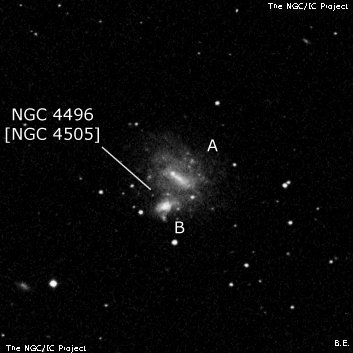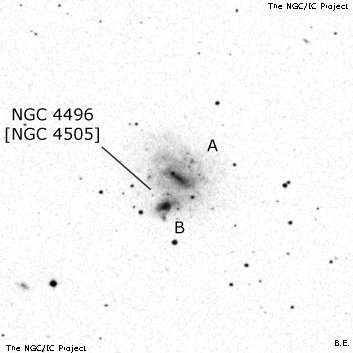NGC/IC Project Restoration Effort
(This is a very very beta version)
NGC4505


Basic Information
Location and Magnitude
Right Ascension: 12:31:40.8
Declination: +3:55:36
Constellation: VIR
Visual Magnitude: 13.9
Historic Information
Discoverer: Herschel W.
Year of discovery: 1784
Discovery aperture: 18.7
Observational
Summary description: vF, cL, r, f of 2
Sub-type: IBm
Corwin's Notes
=====
NGC 4505 is probably NGC 4496. Originally found by William Herschel on
23 February 1784, there is no trace of this on the sky. Yet John Herschel
claims to have observed it, too, and it is listed in Reinmuth's photographic
reobservation of the Herschel's nebulae. After that, however, it disappears
from the catalogues except to appear in errata lists. RC1, for example,
considers it to be identical to NGC 4496.
Sir William has only one observation of it, and that is referred to a
different star than his discovery observation of the nearby NGC 4496, of which
he has 3 observations altogether. His description of NGC 4505 -- "vF, cL, r"
is brief and could just be construed as a hurried observation of NGC 4496.
The positions are not that much different, either.
Sir John's single observation places NGC 4505 close to his father's position.
His description is even briefer: "eF; the f of 2 in the field." His right
ascension is marked "+-", so it is likely that we shall never know exactly
what he saw, but there are several faint stars near his place that he could
have mistaken for an "eF" nebula.
Reinmuth's extended description, "eeF, eS, R; = neb * or *14; *8 sp 7', *11.8
sp 2'; NGC 4505, *11.8, *8 in line" pinpoints a 14th magnitude star near Sir
John's place. This may be the star that Sir John himself saw and mistook for
a nebula.
We are left, then, with Sir William's lone discovery observation to explain.
Arguing against the equality with NGC 4496 are the different positions, and
the fact that both nebulae were found the same night. However, since
different comparison stars were used, it is indeed possible that the two
observations that night refer to the same object -- NGC 4496. Until Sir
William's original observing notes can be scrutinized, I'll adopt the identity
as a working hypothesis.
-----
Looking into this again after being directed to LdR's observation of NGC 4496,
I checked the sweep and found some very odd things there. This is 13th object
in the sweep (not counting a meteor), and is said to be 11' 45" following 16
Virginis and north by 38 arcminutes. Just a minute of time earlier, however,
is another nebula at exactly the same distance north of 16 Vir. Reducing
these observations gives positions about 30 seconds east and west of NGC 4496
where there is nothing on the sky. Assuming errors of 1 degree in recording
the NPD also leads to areas on the sky where there is nothing. Did WH somehow
manage to record NGC 4496 twice? The descriptions are suspiciously similar,
too. For the western object, he writes, "A faintish pL nebula, it seems to be
resolveable [sic]", and for the eastern, "vF of a consid size; it seems to be
resolvable [sic], is more F than the foregoing and rather larger."
Reading through the rest of the sweep also leads to some rather curious
circumstances. For instance, about 45 minutes before WH recorded these two
nebulae, he wrote, "An accident happened to the pulleys, but being set right
immediately, I suppose it has made no change, neither in time nor zero."
Other objects in the sweep referred to 16 Vir are
WH Position Modern Position W - M
RA (2000) Dec RA (2000) Dec DelRA DelDec
NGC 4409 12 26 25 +02 29.1 12 26 58.5 +02 29 40 -33.5 -34
NGC 4412 12 27 09 +03 57.2 12 26 36.1 +03 57 53 32.9 -41
NGC 4457 12 29 09 +03 34.2 12 28 59.0 +03 34 14 10.0 -02
NGC 4527 12 33 40 +02 37.4 12 34 08.4 +02 39 14 -28.4 -110
This is an early sweep, and WH was recording his objects with a precision of
only of 15 seconds. In this set of seven observations -- the star and the six
nebulae -- only 16 Vir, NGC 4409, and NGC 4527 were recorded to that accuracy.
The other four are given to a full minute of time only. It's no wonder that
their RAs are not very good.
In any event, all this convinces me that WH somehow did in fact record
NGC 4496 twice in the sweep, once ahead of its true meridian passage, and once
following. I also note that his published offset for NGC 4496 comes from
another later sweep where the galaxy was referred to 60 Virginis. That
observation is considerably more accurate than the ones recorded here, one of
which was apparently taken as the first observation of NGC 4496.
So, the conclusion is that NGC 4505 is indeed identical to NGC 4496.
Steve's Notes
=====
NGC 4505
See observing notes for NGC 4496.



